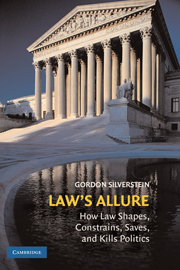Book contents
- Frontmatter
- Contents
- Acknowledgments
- LAW'S ALLURE
- Introduction: Law's Allure: The Juridification of American Politics and Public Policy
- PART I LAW'S ALLURE: WHY, WHY NOW, AND WHY IT MATTERS
- PART II LAW'S ALLURE: PATTERNS, PROCESS, AND CAUTIONARY TALES
- 4 Poverty and Abortion: The Risks and Rewards of a Judicial Strategy
- 5 Environmental Regulation: A Constructive Pattern
- 6 Campaign Finance: A Deconstructive Pattern
- 7 The Separation of Powers: When the Court Says Yes – and No
- 8 War Powers and Precedent: When the Court Is Reluctant to Intervene
- PART III LAW'S ALLURE: COSTS AND CONSEQUENCES
- Conclusion: The Promise and Peril of Law's Allure
- Bibliography
- Index
- References
5 - Environmental Regulation: A Constructive Pattern
Published online by Cambridge University Press: 05 June 2012
- Frontmatter
- Contents
- Acknowledgments
- LAW'S ALLURE
- Introduction: Law's Allure: The Juridification of American Politics and Public Policy
- PART I LAW'S ALLURE: WHY, WHY NOW, AND WHY IT MATTERS
- PART II LAW'S ALLURE: PATTERNS, PROCESS, AND CAUTIONARY TALES
- 4 Poverty and Abortion: The Risks and Rewards of a Judicial Strategy
- 5 Environmental Regulation: A Constructive Pattern
- 6 Campaign Finance: A Deconstructive Pattern
- 7 The Separation of Powers: When the Court Says Yes – and No
- 8 War Powers and Precedent: When the Court Is Reluctant to Intervene
- PART III LAW'S ALLURE: COSTS AND CONSEQUENCES
- Conclusion: The Promise and Peril of Law's Allure
- Bibliography
- Index
- References
Summary
Nine days after richard m. nixon's inauguration on a cold, cloudy day in January 1969, an oil well blew off the coast of Southern California, pumping about 200,000 gallons of oil onto the popular beaches of Santa Barbara, killing thousands of birds and fish. Just two months later, sparks from a freight train trundling over an aging trestle in the industrial Flats section of Cleveland set the Cuyahoga River on fire. It was not a large fire. It was not the first time the Cuyahoga had burned, and it was far from the first time flames had leapt from rivers running through America's industrial cities. But the Cuyahoga fire, coming so soon after the oil spill, accelerated what the New York Times noted was a rising concern about the “environmental crisis,” a crisis that seemed to be “sweeping the nation's campuses with an intensity that may be on its way to eclipsing student discontent over the war in Vietnam.” The crisis generated an extraordinary leap-frog of legislation and court rulings, which led to more legislation with ever more reliance on litigation and more legislation that, in turn, guaranteed easier access to the courts for yet more litigation.
There can be no question that America's air and water are cleaner today than they were in 1969. Judges and courts certainly did not effect this change alone, but just as certainly the environment would look dramatically different today had the courts and key federal judges not played critical roles, shaping environmental policy together with politicians, interest groups, lobbyists, and lawyers alike.
- Type
- Chapter
- Information
- Law's AllureHow Law Shapes, Constrains, Saves, and Kills Politics, pp. 128 - 151Publisher: Cambridge University PressPrint publication year: 2009



